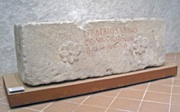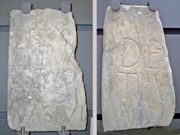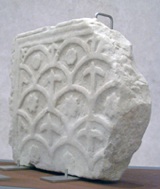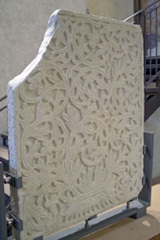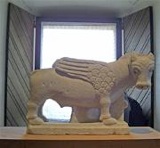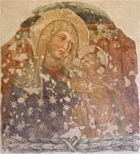

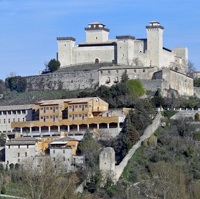
This museum was opened in 2007 in the Rocca di Albornoz to house exhibits that document the history of the Duchy of Spoleto.
Room 1
1.1 Sarcophagus of Pontia (early 4th century)
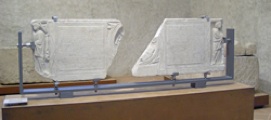
This sarcophagus was documented in the 18th century in the Oratorio di San Giovenale, in the cemetery of Macerino, some 11 km north east of Carsulae. The long inscription records that it belonged to Pontia, a Roman matron who died during a journey, and it seems likely that she was buried in an early Christian cemetery here. The central relief, which no longer survives, depicted a bust of Christ and a “Chi Rho” cross that was the monogram of the Emperor Constantine.
1.3 Sarcophagus of Lucius Baebius Sabinus (late 4th century)
1.4 Sarcophagus of the Good Shepherd (5th century)
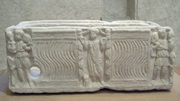
1.7 Terracotta Sarcophagus (6th century)
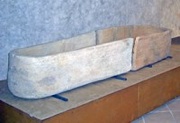
Room 2
2.1 and 2.2 Funerary Inscriptions (4th or 5th century)
-
✴CIL XI 4984 commemorates No[nna], who died on 6th July (pridie nonas iulias); and
-
✴CIL XI 4985 commemorates [Pe]tru[s] Val ...
(These names are the best guesses from the surviving fragments).
2.3 Funerary inscription for Bishop Spes (ca. 380)
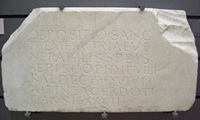
The inscription reads:
DEPOSITIO SANCTAE MEMORIAE VENERABILIS SPEIs AEPISCOPI
DIE VIIII KAL DECB
QUI VIXIT IN SACERDOTI O ANNIS XXXII
Here lies Bishop Spes of venerable memory, who died on 21st November (literally, nine days before 1st December), having lived as bishop for 32 years.
2.5 Funerary Inscription (404 AD)
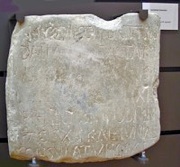
2.7 Inscription (420 AD)
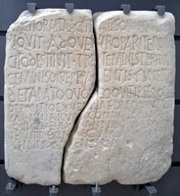
2.8 Inscribed architrave (mid 5th century)
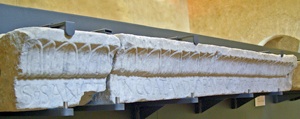
This architrave, which seems to have formed part of it portico of the first church of San Pietro, was discovered in the 1960s. It contains an inscription (5th century) that refers to a construction project that was undertaken with the help of God.
2.9 Architrave (mid 5th century)
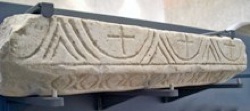
This decorated architrave came from the first church of San Pietro.
Room 4
Mosaic (6th century)
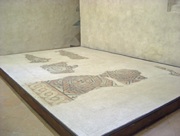
Room 5
Sarcophagus of St Isaac (12th century)
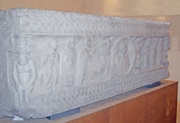
The central relief depicts Christ in a mandorla surrounded by the symbols of the Evangelists. The figures to the sides are:
-
✴an Apostle, a monk (perhaps St Isaac) and the Virgin to the left; and
-
✴a monk (perhaps St Martial, a companion of St Isaac), an Apostle and a bishop to the right.
Sarcophagus of Blessed Gregory (1486-8)
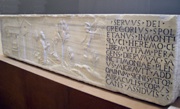
This marble sarcophagus was made for his relics as part of an extensive programme of decoration of a chapel (ca. 1473 ) in the right aisle of the Duomo that was dedicated to him. It was moved to the left transept when the chapel was demolished as part of the re-modeling of the Duomo in 1785-92 and entered the civic collection in 1910. (An altarpiece from the chapel, which depicts the Madonna and Child with St Clement I and the Blessed Gregory, is now in the left transept of the Duomo.)
The relief on the front of the sarcophagus depicts Gregory in prayer outside his hermitage as an angel appears to him bearing a scroll. The long inscription says that he lived a celibate life as a hermit and that performed miracles after his death.
Room 6
Grave Goods from Nocera Umbra (ca. 600)
These grave goods came from a Lombard necropolis that was discovered near Nocera Umbra in 1897. It consisted of some 166 tombs that were arranged in line along an east-west axis and belonged to a number of family groups of various social standings. The tombs were discovered in tact and excavated systematically, which allowed the examination of the way these families had adapted over time to their contacts with Roman culture.
The people in the oldest tombs were buried in traditional Lombard costume, but those buried towards the end of the period had adopted the dress of their Roman neighbours. There was little evidence of their religious beliefs, except for a lovely bone casket (6th century) carved with a relief of the sacrifice of Isaac and Daniel in the lions’ den. This is now (like most of the grave goods from the site) in the Museo dell’ Alto Medioevo, Rome.
-
✴The men were all warriors, many of them cavalrymen, and they were buried with their weapons.
-
✴The women were buried with personal items that included sophisticated jewelry made from glass, amber, rock crystal, amethyst, pearls, silver and gold.

A number of the tombs belonged to children, who were also buried with their jewelry. This example, a child's bracelet (6th or 7th century) came from Tomb 102.
Room 7
Relief (8th century)
Capital (8th century)
Room 8
Relief (late 8th century)
Annunciation (9th century)
Room 9
9.1 Martyrdom of SS John and Paul (late 12th century)
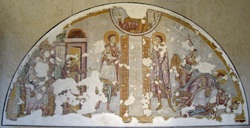
This important fresco, which is attributed to Alberto Sotio, was detached from the crypt of SS Giovanni e Paolo in 1961.
-
✴To the left, the Emperor Julian the Apostate orders the brothers' execution.
-
✴To the right, they are beheaded.
-
✴In the centre, they stand at the gates of Heaven, with Christ in judgment above.
9.2 Symbol of St Luke (13th century)
9.3 Lunette (12th or 13th century)
9.4 Lions (12th century)

9.21 Frescoes (ca. 1300) from Santa Maria inter Angelos
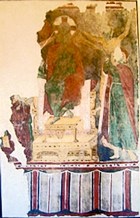
The museum exhibits sinopie of three other frescoes from the cycle, which depict:
-
✴the Last Supper, with an inset of the Agony in the Garden at the lower right, the original of which is now in the Worcester Art Museum, Worcester, Massachusetts;
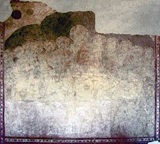
-
✴Christ in Judgement and the Madonna della Misericordia, the original of which is apparently in the Raymond Pitcairn Collection, Glencairn Museum, Pennsylvania; and
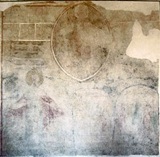
-
✴the Crucifixion (now apparently in the Worcester Art Museum).
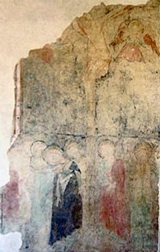
The database of the Federico Zeri Foundation contains images of some of the original frescoes in the cycle. These include the scenes above, except for the Last Supper, and:
-
✴an Annunciation (now apparently in the Raymond Pitcairn Collection, Glencairn Museum, Pennsylvania);
-
✴a female saint and a soldier (now apparently in the Worcester Art Museum); and
-
✴a scene of the Nativity, a fragment of which is now in the Museum of Fine Arts , Boston, Massachusetts.
9.24 Martyrdom of St Blaise (12th or 13th century)

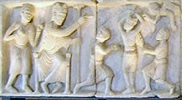

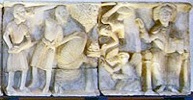
This relief was removed from the external left wall of San Nicolò in the 19th century. It probably came originally from San Biagio (later Sant’ Alò), which belonged to San Nicolò.
The relief depicts scenes from the martyrdom of St Blaise:
-
✴he is hung from a tree while his flesh is removed using carding combs (which are implements for removing stones from shorn wool);
-
✴[what is happening here ??]; and
-
✴his arms are cut off before he is beheaded
9.26 Christus Triumphans (early 14th century)
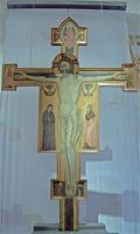
-
✴Christ in judgment appears at the top;
-
✴the Virgin and St John the Evangelist stand to the sides;
-
✴SS Stephen and Thomas stand at the ends of the horizontal beam of the cross; and
-
✴SS Francis and Dominic kneel at its foot.
9.27 Christus Patiens (13th century)
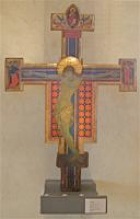
-
✴Christ in judgment appears at the top;
-
✴the Virgin faints and is supported by her ladies on the left; and
-
✴[Longinus and which other figures are on the right?].
Room 11
11.1-4 Religious Objects from San Paolo inter Vineas
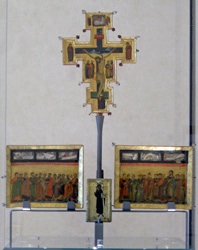
This display of works of art from San Paolo inter Vineas comprises:
-
✦An icon (ca. 1200) of Christ (mounted below the Crucifix in the present arrangement) that seems to have been a gift to the nuns from Pope Gregory IX in 1234. It was probably painted in Venice and was subsequently enclosed in the present gilded silver reliquary (18th century).
-
✦Two double-sided reliquaries (late 13th or early 14th century) that contain relics that Gregory IX also gave to the nuns in 1234:
-
✴The double-sided Crucifix depicts Christus Patiens with the Virgin and St John the Evangelist at the extremes of the cross. A number of relics are housed at the top of the cross: the inscription on the reverse records that they include a relic of the True Cross as well as relics of all the saints illustrated on the Crucifix. Each side of the double-sided Crucifix depicts Christus Patiens with the Virgin and St John the Evangelist at the extremes of the cross:
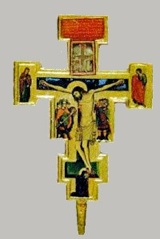
-
•On the side illustrated above, SS Mary Magdalene, Paul, Peter and John the Baptist flank the body of Christ and St Francis kneels at the foot of the cross; and
-
•on the other side illustrated to the right, a group of soldiers surround the body of Christ, one of whom pierces His side and St Clare kneels at the foot of the cross.
-
✴The two reliquaries with pictures of saints originally formed a single, two-sided reliquary. The long inscriptions under the visible relics identify them as belonging to the saints depicted below.
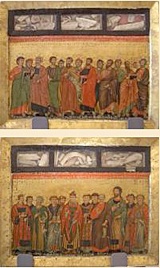
The reliquaries were first documented in Sant’ Alò, and the painted images on them are the autograph works of the Maestro di Sant’ Alò. The nuns took these precious objects to Trevi when they moved there in 1965, but the Commune managed to acquire them in 1982.
Room 13
13.1 Madonna and Child (14th century)
13.2 Reliefs (late 13th or early 14th century)
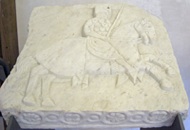
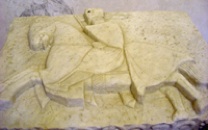
These marble reliefs of knights are from the Ponte della Ponzianina (see Walk II). The present structure is modern, but there must have been other bridges here at least from Roman times. Each of these reliefs from one of these earlier bridges depicts a knight on horseback (perhaps St Pontian.
13.3 St Pontian (14th century)
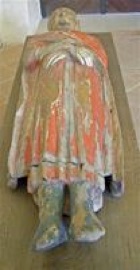
Room 14
14.1 Architrave (1463)
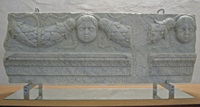
These surviving fragments from a marble sculpted architrave are from the Duomo. The inscription gives the date and the name of the donor, Canon Filippo di Jacopo.
14.3 Sant’ Eutizio Polyptych (1472)
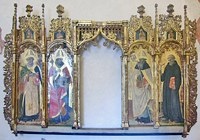
This polyptych by Nicola di Ulisse came from the Abbazia di Sant’ Eutizio outside Norcia. It was moved to Spoleto for security in 1883 after the theft of a precious reliquary from the abbey. It was restored in 1920 and again in 1983. An inscription that was legible in the 16th century recorded the name of the artist and the date.
The central space, which is now empty, probably originally housed a statue (perhaps of the Madonna and Child or of St Eutychius). The remaining figures depict:
-
✴SS Placidus and Benedict on the left; and
-
✴SS Spes and Florentius (with his bear) on the right.
14.4 Triptych (15th century)
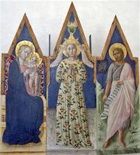
-
✴Santa Maria delle Grazie, which must have referred to the image of the Madonna and Child enthroned on the left;
-
✴Santa Maria dell’ Assunta, which must have referred to the image of the standing Virgin crowned by angels at the centre; and
-
✴St John the Baptist.
They are attributed on stylistic grounds to Nicolò di Liberatore, l' Alunno and Ugolino di Gisberto.
The original location of the panels is unknown: they could have come from San Giuliano or from the earlier hermitage on the site of the Eremon di Santa Maria delle Grazie. They passed to the Congregazione di Carità in ca. 1860 and entered the Pinacoteca Comunale in 1921.
Room 15
15.1 Madonna and Child with Franciscan saints (ca. 1450)
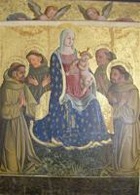
The altarpiece depicts the Madonna and Child with SS Francis, Bernardino of Siena and Antony of Padua and the Blessed Simon. He is identified by the words “Sanctus Simon” inscribed in his halo despite the fact that he was never canonised.
15.2 SS John the Baptist and Peter (1466)
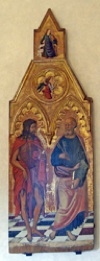
-
✴the Madonna and Child; and
-
✴SS Paul and Francis.
15.3 Madonna and Child enthroned (1494)
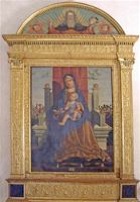
-
✴The main panel is based on the central panel of the important San Cassiano Altarpiece by Antonello's uncle, Antonello da Messina from San Cassiano, Venice.
-
✴The lunette contains a figure of God the Father between angels in tondi.
